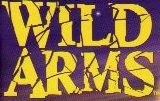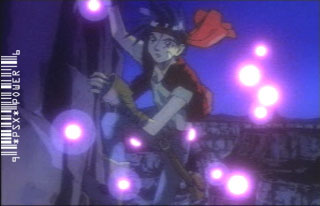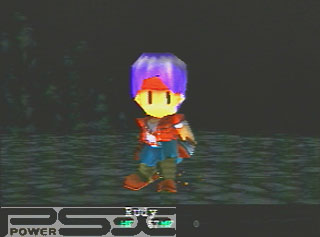|
|

|
PLATFORM
|
PSX
|
BATTLE SYSTEM
|

|
INTERACTION
|

|
ORIGINALITY
|

|
STORY
|

|
MUSIC & SOUND
|

|
VISUALS
|

|
CHALLENGE
|
Moderate
|
COMPLETION TIME
|
20-40 Hours
|
|
OVERALL

|
+ Decent battle system.
+ Some of the puzzles are okay.
+ Good music.
- Can be hard at times without a guide.
- Weak story.
- Ugly battle graphics.
|
Click here for scoring definitions
|
|
|
Three Dream Chasers, a mysterious young boy named Rudy with the ability to operate powerful weapons known as ARMs (Ancient Relic Machines), a treasure hunter named Jack, and a princess named Cecilia, cross paths and must stop a group of villains known as the Quarter Knights from reviving their leader and destroying their world. The Media Vision-developed, Sony-published Wild ARMs was released in North America in 1997 on the heels of the immensely-popular Final Fantasy VII. While it certainly didn't set the RPG world on fire and does have its share of flaws, it does have a few things going for it.
Wild ARMs features randomly-encountered battles with Rudy, Jack, and Cecilia facing off against a group of enemies. Each has the standard RPG commands of attacking, defending, and using items, although the player can also attempt to escape, yet this option, as one can expect, doesn't always work. Each character also has unique abilities, such as Rudy's ARMs, each having a certain number of bullets refillable at inns or with bullet clips (with the player able to upgrade their attack power, accuracy, and bullet capacity at special facilities); Jack's MP-consuming Fast Draws, with new ones occasionally gained during certain events (and which remain "unknown" until used a certain number of times); and Cecilia's MP-consuming magic, with the player able to get her new spells at Magic Guilds with Crest Graphs.
Each character also has up to four unique Force Abilities, usable with Force Points gained as characters attack or receive damage, among them being Rudy's Lock-On, which maximizes the accuracy of his ARMs and somewhat renders upgrading their accuracy useless; Jack's Accelerate, which guarantees him the first turn in a round; and Cecilia's Mystic, which extends an item's effect to the whole party. Characters can also equip a stat-affecting Guardian and summon it into battle with Force Points as well. It's a decent battle system overall, although it does suffer from the typical flaw of unpredictable and sometimes inconsistent turn order during each round of combat, and the encounter rate can be annoying too, though a spell can lower their occurrence.
 Rudy in anime form...
Rudy in anime form...
|
|
The interface isn't half bad, with clean menus, easy shopping, no problem with inventory space, and so forth, though there are some flaws such as frequent terrible direction on how to advance the game. Dungeons, moreover, tend to have a variety of puzzles that the player must solve with Tools each character acquires sporadically throughout the game, and while most aren't bad, there are some that can be fairly difficult without a guide. Dungeon design itself can be somewhat convoluted at times, and those playing the game on the Playstation 2 may experience occasional freezes. All in all, interaction isn't terrible, but could've certainly been better.
The western atmosphere of the original Wild ARMs was pretty much its defining characteristic, with its gameplay and story being highly derivative, and Lufia II: Rise of the Sinistrals seeming to be its main source of inspiration. The Force Points system resembles a similar battle mechanic in the first Lufia sequel, with both games having an emphasis on puzzles, as well, and the Quarter Knights basically being knockoffs of the Sinistrals from the Lufia games. Ultimately, the first Media Vision production certainly wasn't a unique experience.
The story itself isn't all that great, with recognizable narrative staples of RPGs such as spirited youths destined to save the day, a protagonist with a mysterious past, a character becoming temporarily incapacitated for part of the game, villains trying to take over/destroy the world, and so forth. The western motif, moreover, is something of an afterthought, with an odd inclusion of medieval castles. The translation is okay, but does have some incongruities, with lines such as "I'm back at this place of hatred. The hatred between a child and a parent." and weird name choices such as "Sweet Candy" (for a ship) and "Elw" (neither the game nor its instruction book say how to pronounce this). Granted, the main characters and maybe one villain do have some sort of story behind them, but the plot is hardly a reason to play the game.
 ...and Bomberman form
...and Bomberman form
|
|
The music, thankfully, is much better, with Michiko Naruke providing a nice western-themed soundtrack with pieces such as the main theme, "Into the Wilderness," accompanied by actual human whistling. Some of the sound effects, though, are somewhat dated (a few actually sound like they came straight off the Atari 2600) and at times out of place (goblins meow like cats when attacked), but this aside, the aurals are one of the game's strongest points.
The visuals have some things going for them, such as the introductory anime sequence and the anime stills during the ending, with the game environs looking nice, as well, but the depiction of all human characters as, for lack of a better term, Bombermen, doesn't really enhance the mood of the game. The battle graphics, where the Bomberman-esque appearance of the main characters is most apparent, are easily the low point of the visuals, with most enemies showing a considerable degree of blockiness, as well. Still, this was an early Playstation RPG, so the visuals, despite looking at times as though the creators of the Bomberman games had incriminating evidence on the developers, are by no means bad, yet could've certainly been better.
Finally, the game is a little on the short side, taking a little over twenty hours to complete in a straightforward playthrough, although a few sidequests can naturally boost this time. Overall, Wild ARMs is an okay start to Media Vision's staple franchise, having strong points such as a decent battle system and good music albeit a number of shortcomings such as the difficulty of playing at times without a guide, a weak plot, and ugly battle graphics. The first installment would see reincarnation on the Playstation 2 in the form of Wild ARMs: Alter Code F, although there are a select few fans who consider the original version superior.
Review Archives
|









